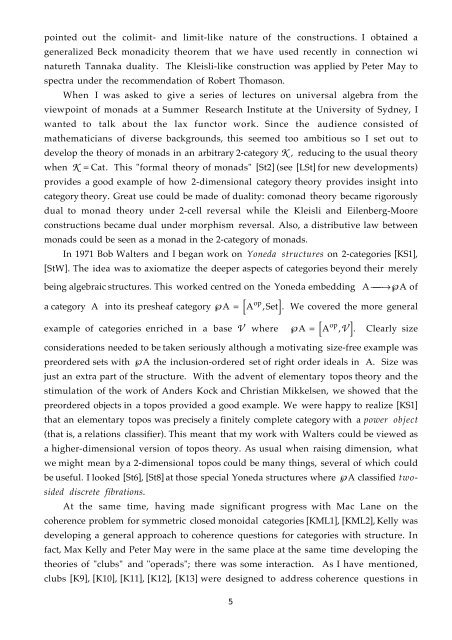An Australian conspectus of higher categories - Macquarie University
An Australian conspectus of higher categories - Macquarie University
An Australian conspectus of higher categories - Macquarie University
Create successful ePaper yourself
Turn your PDF publications into a flip-book with our unique Google optimized e-Paper software.
pointed out the colimit- and limit-like nature <strong>of</strong> the constructions. I obtained a<br />
generalized Beck monadicity theorem that we have used recently in connection wi<br />
natureth Tannaka duality. The Kleisli-like construction was applied by Peter May to<br />
spectra under the recommendation <strong>of</strong> Robert Thomason.<br />
When I was asked to give a series <strong>of</strong> lectures on universal algebra from the<br />
viewpoint <strong>of</strong> monads at a Summer Research Institute at the <strong>University</strong> <strong>of</strong> Sydney, I<br />
wanted to talk about the lax functor work. Since the audience consisted <strong>of</strong><br />
mathematicians <strong>of</strong> diverse backgrounds, this seemed too ambitious so I set out to<br />
develop the theory <strong>of</strong> monads in an arbitrary 2-category K , reducing to the usual theory<br />
when K = Cat. This "formal theory <strong>of</strong> monads" [St2] (see [LSt] for new developments)<br />
provides a good example <strong>of</strong> how 2-dimensional category theory provides insight into<br />
category theory. Great use could be made <strong>of</strong> duality: comonad theory became rigorously<br />
dual to monad theory under 2-cell reversal while the Kleisli and Eilenberg-Moore<br />
constructions became dual under morphism reversal. Also, a distributive law between<br />
monads could be seen as a monad in the 2-category <strong>of</strong> monads.<br />
In 1971 Bob Walters and I began work on Yoneda structures on 2-<strong>categories</strong> [KS1],<br />
[StW]. The idea was to axiomatize the deeper aspects <strong>of</strong> <strong>categories</strong> beyond their merely<br />
being algebraic structures. This worked centred on the Yoneda embedding A æÆ æ √A <strong>of</strong><br />
op<br />
a category A into its presheaf category √ A = [ A , Set]<br />
. We covered the more general<br />
example <strong>of</strong> <strong>categories</strong> enriched in a base V where √ = A [ A ] op ,V . Clearly size<br />
considerations needed to be taken seriously although a motivating size-free example was<br />
preordered sets with √A the inclusion-ordered set <strong>of</strong> right order ideals in A. Size was<br />
just an extra part <strong>of</strong> the structure. With the advent <strong>of</strong> elementary topos theory and the<br />
stimulation <strong>of</strong> the work <strong>of</strong> <strong>An</strong>ders Kock and Christian Mikkelsen, we showed that the<br />
preordered objects in a topos provided a good example. We were happy to realize [KS1]<br />
that an elementary topos was precisely a finitely complete category with a power object<br />
(that is, a relations classifier). This meant that my work with Walters could be viewed as<br />
a <strong>higher</strong>-dimensional version <strong>of</strong> topos theory. As usual when raising dimension, what<br />
we might mean by a 2-dimensional topos could be many things, several <strong>of</strong> which could<br />
be useful. I looked [St6], [St8] at those special Yoneda structures where √A classified twosided<br />
discrete fibrations.<br />
At the same time, having made significant progress with Mac Lane on the<br />
coherence problem for symmetric closed monoidal <strong>categories</strong> [KML1], [KML2], Kelly was<br />
developing a general approach to coherence questions for <strong>categories</strong> with structure. In<br />
fact, Max Kelly and Peter May were in the same place at the same time developing the<br />
theories <strong>of</strong> "clubs" and "operads"; there was some interaction. As I have mentioned,<br />
clubs [K9], [K10], [K11], [K12], [K13] were designed to address coherence questions in<br />
5
















